By Paul Roggemans and Carl Johannink
The registration of a bright multiple station meteor that proved to belong to the December alpha Bootids (DAB – 497) resulted in a search for earlier orbits of this minor shower registered by the CAMS BeNeLux network as well as all major video networks. A cluster with 78 similar orbits was identified, radiating from RA 212.3° and Decl. +22.0° with a geocentric velocity of 59.6 km/s in a time lapse from 257° to 273° in solar longitude with best activity at ~263.9°. The orbital elements match perfectly with previously published results. There is no indication for any periodicity in the shower displays which is remarkably rich in bright meteors and rather deficient in faint meteors. Being detected independently from orbital data collected by different video networks, confirmed by 78 orbits with a medium threshold D criterion DD < 0.08 and 43 orbits with a high threshold of DD < 0.04, this minor shower could be considered to be listed as an established meteor shower.
1 Introduction
A bright meteor captured by CAMS 315 (Johannink, Gronau) was identified as a December alpha Bootids (497), a minor shower detected only few years ago. The reference orbits listed in the IAU Meteor Shower list are based on a very small sample of related orbits that were identified with a very high threshold on the discrimination criteria. Except for its orbital elements, the shower remains poorly documented. The low numbers of orbits listed in the IAU Meteor shower list indicate that these meteors are rather rare and difficult to collect. The occurrence of one of these orbits in the CAMS BeNeLux data for 2017 triggered some curiosity if and how many orbits we had obtained previous years. At the same time this offers a good challenge to experiment with a stream search using the latest available orbit databases.
2 The December alpha Bootids (497) of 2017
In the early morning of December 16, just one minute before the CAMS session for that night closed, camera 312 in Gronau captured a very bright meteor through the clouds (Figure 1). Very soon, it became clear that six other stations in the BeNeLux captured this meteor too. Besides Gronau (Carl Johannink), Texel (Robert Haas; see Figure 2), Ooltgensplaat (Piet Neels), Wilderen (Jean-Marie Biets), Mechelen (Paul Roggemans) and Leiden (Hans Betlem). The first four stations could be used to calculate an orbit. We found a radiant near RA = 213.7° and Decl. = 21.2° with geocentric velocity vg = 59.0 km/s, resulting in an orbit with orbital elements listed in Table 1. This corresponds very well with the radiant and orbital elements for # 497 DAB in the IAU database. Some all sky stations captured this meteor too (Figure 3; photo Ermelo, Figure 4; photo Bussloo). A search in all ~2500 orbits obtained by our network in December 2017, revealed no other DAB – meteors.
Figure 1 – December alpha Bootid 2017 December 16, 06h38m35.6s UT on CAMS 312 (Gronau, Carl Johannink).
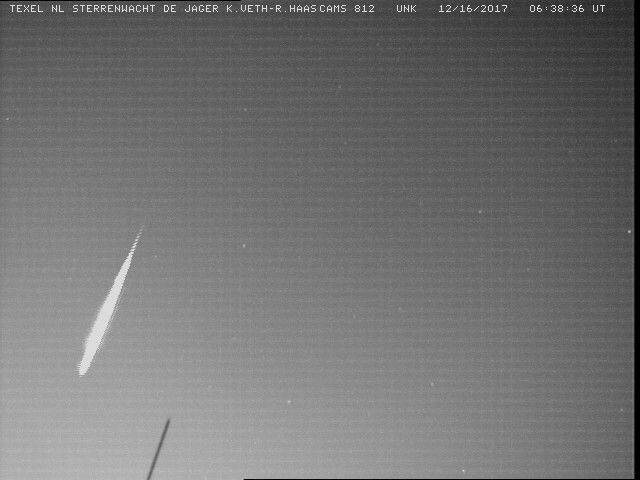
Figure 2 – December alpha Bootid 2017 December 16, 06h38m35.6s UT on CAMS 812 (Texel, Robert Haas).
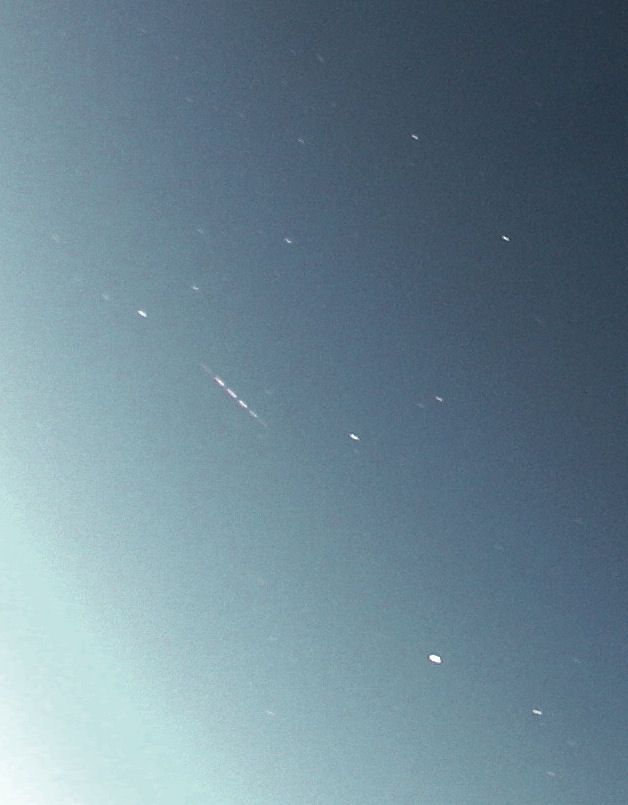
Figure 3 – December alpha Bootid 2017 December 16, 06h38m35.6s UT on All-sky (Ermelo, Koen Miskotte).
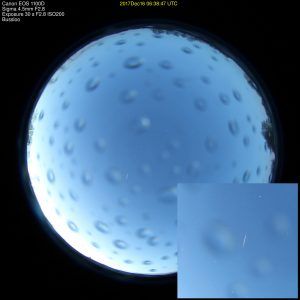
Figure 4 – December alpha Bootid 2017 December 16, 06h38m35.6s UT on All-sky (Bussloo, Jaap Van ‘t Leven).
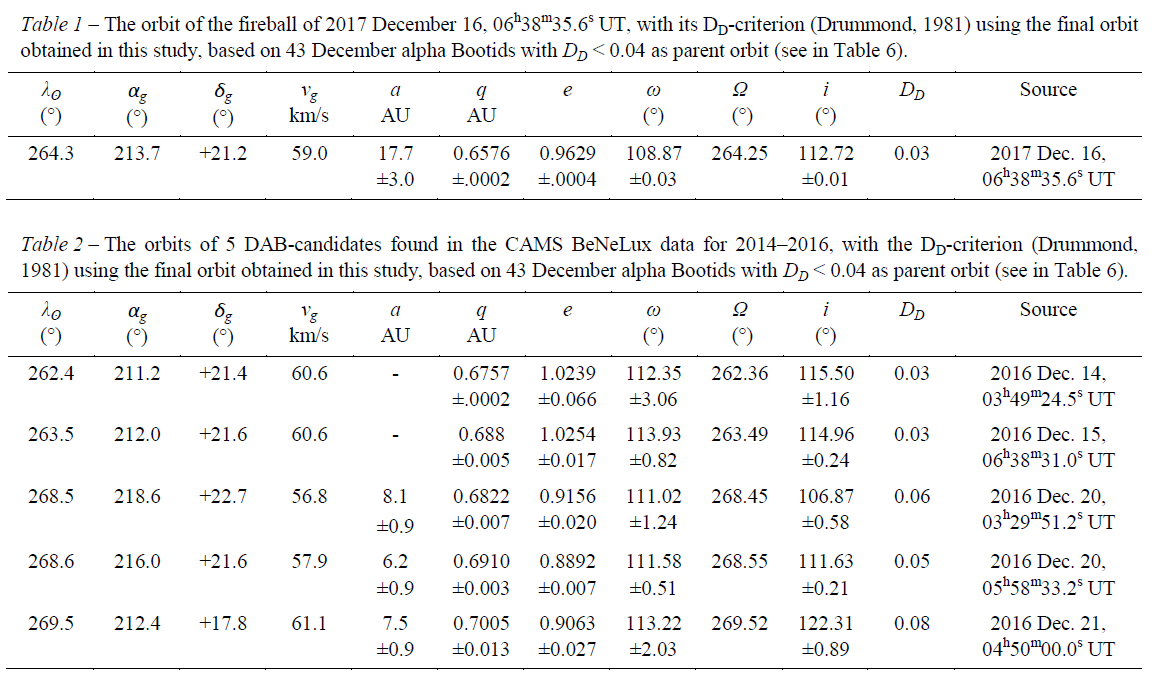
3 CAMS BeNeLux and DABs before 2017
What do we have from other years? We checked all our December data in the years since the start of our network in March 2012. No DAB-candidates in the years 2012 – 2013, but in the following years we captured several meteors that could belong to this stream, but only 5 orbits from 2016 fit the D criterion (Table 2). Another 4 preselected orbits from 2014 and 2015 were omitted as the D-criterion was above the cut-off value.
But how can we be sure whether a meteor really belongs to this stream?
4 The challenge to identify meteor showers
Since the early start of meteor astronomy, meteor showers were recognized by visual observers whenever a significant number of shooting stars appeared to radiate from a small region at the sky, displaying a typical angular velocity. This simple approach permitted to list the principal major annual showers in a reliable way, but led to highly controversial minor shower identifications. Late 19th and first half of the 20th century dedicated meteor observers had no other techniques available. The believe that a relative small sample of backwards produced single station meteor trails allowed to define minor shower radiants resulted in vast number of minor showers, most of which were spurious.
Indeed any backwards produced meteor trail will intersect with its true radiant, but it is not so that a single station meteor which ‘seems’ to intersect with a radiant can be associated with any certainty with some shower radiant. In reality most backwards prolonged trails line up with one or more radiants by chance without having any physical relationship with the meteor shower(s) of the radiant(s). The only way to determine the radiant is by use of triangulation which requires multiple stations observing, with at least data from two different stations with a sufficient long baseline.
With our CAMS BeNeLux network we now manage to collect over 30000 multiple station meteors a year for which the radiant position, the atmospheric trajectory, the entrance velocity and the heliocentric orbit are known. Although that this information identifies an unambiguous radiant position as well as the orbit, the possible association with some meteor shower requires a careful analyses of the orbital similarity. The meteoroid distribution in the solar system consists of a large amount of sporadic meteoroids, particles that were released long ago from some parent source, which have been dispersed by perturbations to an extend that it becomes impossible to reconstruct their origin or to find any associations with any other particles. These lonely particles have radiants all over the sky and share radiant areas of real meteor showers as well as the ‘empty’ regions with no known meteor sources. Known meteor streams represent relative recently produced dust trails, released by parent bodies in the last few 1000ds of years, which is very young in astronomical terms. Only few of these dust trails have favorable intersections with the Earth orbit to produce some major shower event. Some dust trails result from recent perihelion passages of parent comets and didn’t yet distribute along the entire orbit of the stream parent, producing periodic events. Others intersect the Earth orbit at the outer edge of the dust trail and therefore display only few of their particles as meteors in our atmosphere. The main goal of most meteor camera networks is to sample orbits to map the distribution of the dust and to identify the dust trails and their parent objects.
5 Methodology
Being aware of the complexity, researchers developed some methods and tools to detect dust concentrations. One method is to compare each single orbit with all other orbits to find similar orbits. A popular tool to find possible associations is a discriminant to measure the degree of similarity between two orbits. There is no straight forward method to determine whether or not two orbits are physically related to some identical parent. Searching for orbit associations to define minor showers remains an approach to the best effort. The similarity criteria consider the distance between some of the orbital elements combined with the angle between the orbital planes. The first numeric discrimination criterion was proposed by Southworth and Hawkins (1963), referred to as DSH. Later Drummond (1981) introduced a slightly different criterion, referred as DD. Jopek (1993) proposed another version DH, based on the former criteria. We can apply all three criteria combined:
First we determine Γ

Then we calculate ψ, the angle between the two orbital planes from
![]()
Next we calculate Π, the angle between the perihelion points:

λ is the ecliptic longitude of the perihelion, with
![]()
β is the ecliptic latitude of the perihelion, with
![]() where λ has 180° added if cos ω < 0.
where λ has 180° added if cos ω < 0.
The angle θ between the two perihelion points on each orbit is given by the equation:

The three different discriminant criteria can now be calculated from the following equations, with DSH for the Southworth Hawkins criterion, DD for the Drummond criterion and DH for the Jopek criterion:
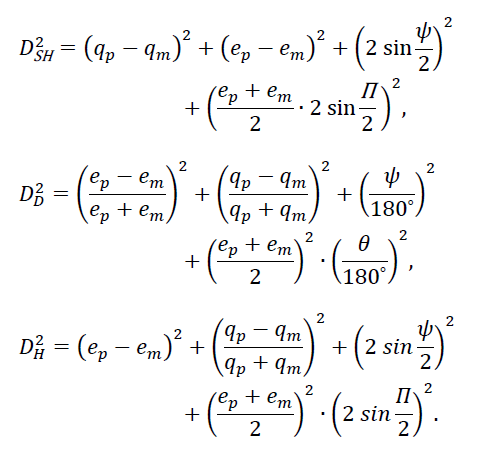
The larger the values of ψ, Π or θ, the bigger the ‘distances’ between the orbits and the less the probability becomes for an association. Related orbits have values in the order of a few degrees. The final values for these similarity criteria are dimensionless numeric values, where 0 represents identical orbits. The smaller the D-values the higher the degree of similarity and the better the probability becomes for an association. The D criteria cannot be applied without caution as the results depend upon the type of orbit. High inclination orbits and retrograde streams prove rather challenging to determine orbit associations with a high probability for inclusion of sporadic meteors. The effect of the type of orbit on the applicability of the D-criteria has been described by Galligan (2001). This explains why the threshold on the D criteria had been put very high for the initial shower searches for DAB 497. As a result of this high threshold, many real DAB meteors were rejected leaving only some very similar orbits of the core of the shower. This way the actual activity duration of the shower remains underestimated.
6 Our approach
Having a well-known reference orbit for the DAB (497) meteor stream, the more likely method would be to take the known reference orbit as parent orbit and to match this with each individual orbit in our dataset to check if it fits within the D criteria cut-off.
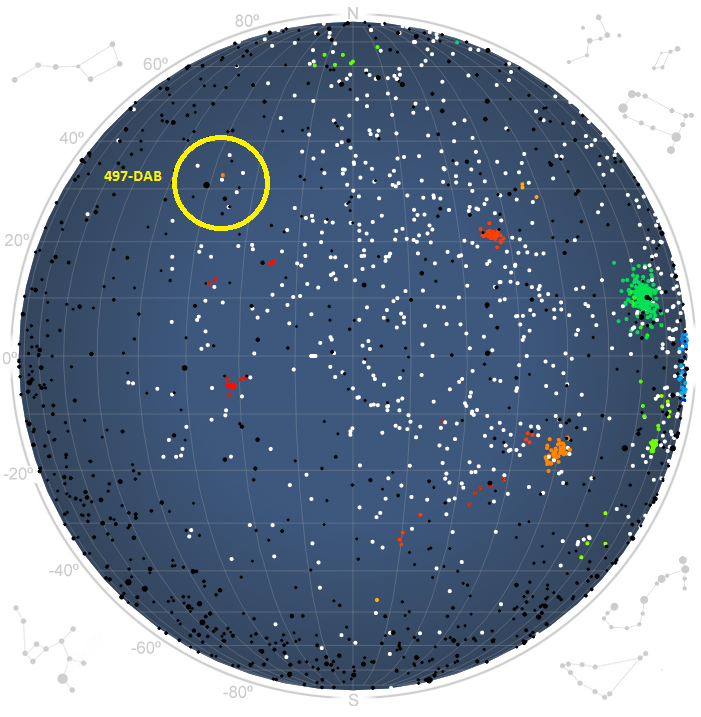
Figure 5 – A radiant map during the December alpha Bootids activity period shows the DAB-radiant location relative to other active shower radiants.
Another approach would be to skip through the dataset of orbits to match each orbit with all other orbits within for instance 15° in solar longitude before and after the instant of the orbit to check whether any clustering of similar orbits occurs. This method would perform an independent new stream search on the currently available datasets. This way would require a considerable amount of computing time and is rather beyond our abilities as amateurs.
Using a known reference orbit as parent orbit to link similar orbits introduces a strong bias to work towards the previously determined orbit. Therefore the authors decided to follow an alternative approach, applying the traditional method that visual observers can use at best to identify probable members of a certain meteor shower, e.g. meteors that appear from a specific area at the sky with comparable velocity within a limited period of time. The result of this preselection is a workable dataset with a limited number of orbits to be compared. If this sample includes a clustering of meteor orbits related to some meteor stream among the purely sporadic population, these orbits should be detected with the D criteria. Figure 5 shows the location of the DAB radiant at a part of the sky with relative few sporadic radiants and away from any other active meteor shower radiant.
An iterative procedure was used, starting with the initial orbits that fulfilled the conditions used to make a preselection of orbits with similar radiant positions and velocity within a limited period of time. This preselection can be called the radiant – velocity method. Starting with a parent orbit based on the median values for the orbital parameters of all preselected orbits, computing the D criteria for each individual orbit relative to this parent orbit, most sporadic orbits in the sample will not fulfil the D criteria. Limiting the preselection to those orbits that fit the D-criteria, re-calculating again the median values for these orbits and substituting the resulting median values as new parent orbit, new D criteria are calculated. Repeating this procedure until all outliers get rejected, a number of very similar orbits will remain that fulfil the D criteria. The challenge is to choose correctly the margins to define the preselection as well as to define realistic cut-off values for the D criteria. Since no standard procedure exists, some try-and-error with common sense, is required to set the appropriate selection criteria.
7 What we already know about DAB – 497
The December alpha Bootids were mentioned a first time among other newly discovered minor showers which resulted from an analyses on the CAMS dataset with 40744 orbits available for the period 2010, October 21 to 2011, December 31 (Rudawska and Jenniskens, 2014). This shower appeared also in a list with detected showers based on the 4th edition of the EDMOND orbit database which included at that time 83369 orbits (Kornos et al., 2014). Finally another stream search with a high threshold of DSH < 0.05 detected this shower again from 111233 orbits of the CAMS dataset until 2013, March 31 (Jenniskens and Nénon, 2016). The orbital elements of these references are shown in Table 6 and compared with the results obtained by the authors.
It is not known if the DAB 497 shower was ever present in older stream searches of orbit catalogues such as radar orbits or photographic data. The photographic meteor orbit catalogue kept by the IAU which contains 4873 orbits does not include any single DAB orbit.
So far, the only information available on DAB has been derived from the CAMS and EDMOND orbit catalogues until 2012. Since then the datasets were tripled in size. We therefore conducted a search in the public available orbit lists, situation as end 2017, to locate more orbits of this shower in order to get a better idea about the activity period as well as the radiant drift. Instead of using a straight forward direct linking between the known DAB orbit and each possible candidate we have chosen to try to detect some clustering of related orbits from a preselected sample with the suspected radiant position and velocity range within a certain time span.
8 The practical work
We have the following data available for our search:
- EDMOND 05v03 with 252425 orbits (until 2015). EDMOND collects data from different European networks (Kornos et al., 2014).
- Sonotaco with 231024 orbits (2007–2016). Sonotaco is an amateur video network with over 100 cameras in Japan (SonotaCo, 2009).
- CMN with 39991 orbits (2007–2013). The Croatian Meteor Network is operated by amateurs with about 20 cameras (Šegon et al., 2012).
- CAMS with 111233 orbits (Oct. 2010 – March 2013), (Jenniskens et al., 2011). For clarity, the CAMS orbits from all CAMS networks between 2013 and 2017 are not included in this dataset.
A first approach
In a first approach we selected orbits within a short time period covering only 7 days with λʘ between 261° and 268°, from a radiant area with αg between 210° and 216°, δg between 20° and 23° and a geocentric velocity vg between 58 and 62 km/s. 51 orbits from EDMOND were found within this range but it was immediately clear that the period covered by this preselection was too short as more candidate DABs were spotted beyond these limits.
A second approach
In a second attempt the selection margins were set a bit wider, for λʘ between 248° and 279°, from a radiant area with αg between 207° and 218°, δg between 16° and 26° and a geocentric velocity vg of 59 ± 7 km/s. A total of 108 orbits from Sonotaco, 60 orbits from EDMOND and 18 orbits from CMN fitted the preselection conditions. The median values for this selection compared remarkable well with the earlier found orbit data for shower 497. Using these median values as the parent orbit, the D criteria rejected more than half of the 186 orbits as outliers with mainly higher inclination, lower eccentricity and larger perihelion distance q. The resulting orbit from the three networks separately as well as the combined data was in good agreement with the existing results from literature.
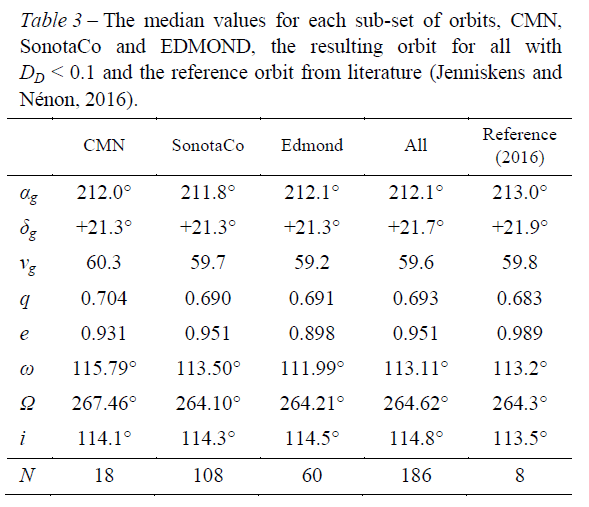
A third approach
In an attempt to determine the activity duration, a third preselection was made covering a longer period of time for λʘ between 245° and 285°, from a radiant area with αg between 205° and 220°, δg between 16° and 27° and a geocentric velocity vg of 60 ± 5 km/s. A total of 199 orbits from Sonotaco, 95 orbits from EDMOND and 22 orbits from CMN fitted the preselection conditions. Applying the same preselection margins on the CAMS dataset, another 60 CAMS orbits were added to this selection. The resulting orbits from the four datasets as well as the combined 376 orbits resulted in a large spread on the orbital elements. Three quarter of all these orbits failed to fit the D criteria. Especially the first 5 days and the final 10 days of the 40 days selection was dominated by orbits with distinct higher inclination, smaller eccentricity and larger perihelion distance. The time span chosen included too many orbits that contaminated the sample to an extent that any clustering of related orbits became too difficult to detect.
A period of 40 days proved too long to approach the DAB orbits as the preselection sample got contaminated with too many sporadic orbits or perhaps some other dust sources in this region. However this third approach allowed us to detect the outer boundaries of the shower. A first DAB candidate was detected at
λʘ = 257.4° and a last one at λʘ = 272.0°. With this information we could chose a realistic time span for another preselection.
At this point we should be aware that all these 376 meteors radiated from the same area at the sky displaying similar angular velocities. Any single station video system would identify all of these meteors as belonging to one and the same meteor shower, based on all observable characteristics. In reality less than 1 on 4 of all these look-alike meteors are real candidate members for the DAB meteor shower, based on accurate orbital data. The low hourly rates of these minor streams make it statistically irrelevant to attempt any single station shower identification. It is the law of (too) small numbers that makes single station observing of this kind of low rate showers of no use. Visual observations will suffer the same contamination in any attempt to derive radiant positions and activity levels from single station statistics. Using single station meteor positions, either by video or visual observing, will always produce some results, but may be spurious. This explains the need for multiple station work in order to obtain unambiguous radiant and orbit identifications.
A fourth and final approach
The previous preselection allowed us to select more appropriate margins for a fourth approach. In this final approach we cover 20 days with λʘ between 255° and 275°, from a radiant area with αg between 205° and 220°, δg between +16° and +26° and a geocentric velocity
vg = 60 ± 4 km/s. This preselection resulted in 13 orbits from CMN, 90 orbits from Sonotaco, 38 orbits from EDMOND and 30 orbits from CAMS.
To check if the preselection is suitable to detect any clustering of orbits, if this would be present at all, the median values were calculated for the 4 different datasets separately. In case these preselected samples were contaminated by too many randomly distributed sporadic orbits, a significant spread should appear on the different median values. However all 4 sub-sets had perfectly comparable median values. The presence of possible DAB candidates was checked by applying the three D criteria starting with a rather low threshold set as DSH < 0.25,
DD < 0.12 and DH < 0.25. When all three conditions were fulfilled, the orbit was considered to be a candidate orbit. The reason to start with a very low threshold is to eliminate outliers step by step without excluding any relevant candidate DAB’s orbits. The type of orbit, high inclination and retrograde, means that the D criteria are not ideal to identify related orbits as explained by Galligan (2001), mentioned in section 5. Common sense and visual evaluation of the numeric data remain essential to obtain a realistic result.
10 out of the 13 CMN orbits, 59 out of the 90 Sonotaco orbits, 28 out of the 38 EDMOND and 19 out of the 30 CAMS orbits survived the first filtering round, altogether 116 orbits of the initial 171 preselected orbits. The average orbits for each sub-set of orbits that fulfil the D-criteria were in perfect agreement with each other as well as with these of the previously published orbits for DABs. A visual check on the parameters used in the D criteria shows that this filtering has removed mainly those orbits with a combination of unfavorable elements such as a too large angle between the orbital planes and a too low eccentricity or a too large angle between the points of perihelion and a deviant inclination.
In order to eliminate the remaining orbits with a significant difference in one of the elements compared to the median value, the cut-off value of the D-criteria was restricted to DSH < 0.2, DD < 0.1 and DH < 0.2 for the whole 171 preselected orbits, sorted on solar longitude. 90 orbits fulfil these criteria and most rejected outliers occur in the first 5° and last 5° in solar longitude. Most DAB candidates appear in the λʘ interval 261°– 270°.
Setting the D criteria cut-off to DSH < 0.2, DD < 0.08 and DH < 0.2 further reduces the number of remaining DAB candidates to 78 orbits. Then an iterative procedure is applied that recalculates the D-criteria, substituting the averaged values of the previous result as parent orbit. The clustering of similar orbits becomes very well visible in a plot of inclination i versus the length of perihelion Π (Figure 6).
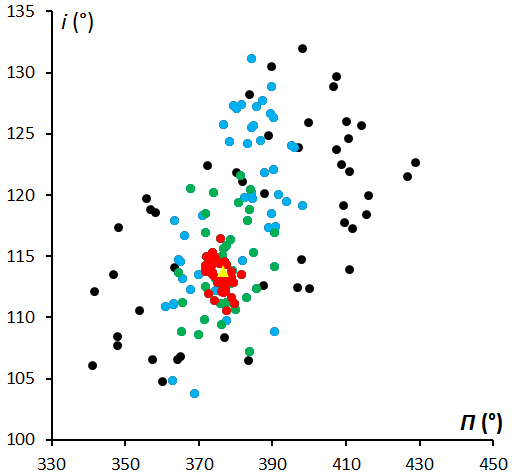
Figure 6 – Plot of inclination i versus length of perihelion Π. The black dots are all 171 preselected orbits, the blue dots are the orbits which fit DSH < 0.25, DD < 0.12 and DH < 0.25. The green dots are orbits that fit DSH < 0.2, DD < 0.08 and DH < 0.2 and the red dots orbits that fit DSH < 0.1, DD < 0.04 and DH < 0.1. The yellow triangle is the position for the final reference orbit.
9 The results
7 out of the 13 CMN orbits, 41 out of the 90 Sonotaco orbits, 18 out of the 38 EDMOND and 12 out of the 30 CAMS orbits survived the final eliminations, altogether 78 orbits of the initial 171 preselected orbits. Sonotaco and CMN did not list any shower association for any of these meteors. EDMOND listed shower associations and had 41 DAB orbits listed 18 of which fit the criteria set in this analyses which includes 1 sporadic orbit listed in EDMOND. CAMS mentioned 8 DAB orbits of which 7 passed our criteria, one orbit failing mainly due to a deviant eccentricity, but 5 sporadic CAMS orbit survived our elimination routine.
From the distribution of the number of orbits against solar longitude we can define the activity period covering 257° to 273° in solar longitude, which is about 9th until 25th December (see Table 4). Maximum activity seems to occur at λʘ ~263.9°, shortly after the Geminid maximum. Jenniskens and Nénon (2016) list a period from 261° to 268° with a maximum at 264°.
There is no indication for any periodic nature in the activity from year to year (Table 5). The number of orbits is still too small to conclude anything about an activity profile. The variations in number of orbits per year can be explained as due to the weather circumstances for each of the contributing networks, combined with years covered by each network. Sonotaco contributed for 2007–2016, EDMOND for 2006–2015, CMN for 2007–2013 and CAMS for 2010–2012.
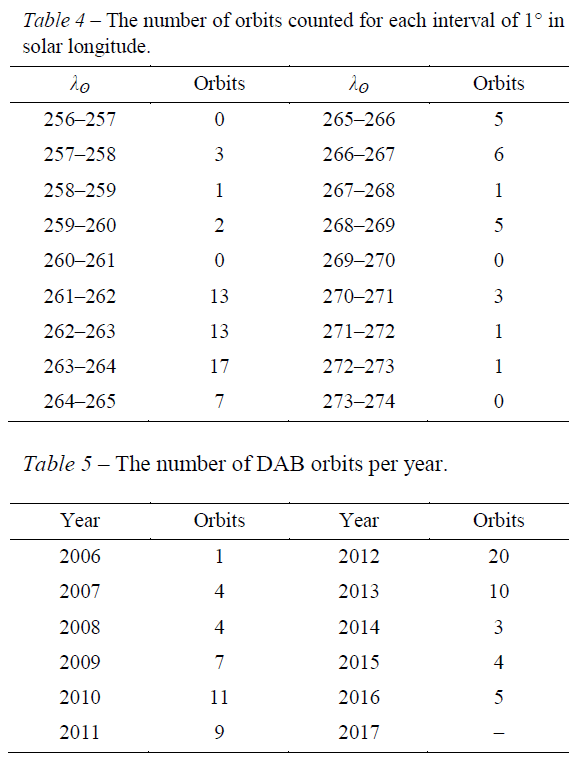
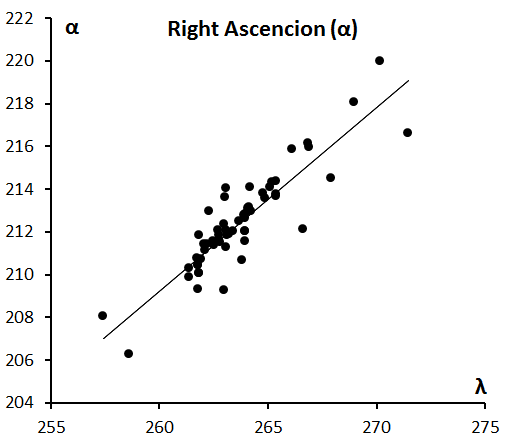
Figure 7 – Linear fit for the right ascention α in function of the solar longitude λʘ.
To determine the radiant drift we limit the selection of radiant points to those orbits with a more strict threshold with DD < 0.06, having still 60 data points included. The radiant drift displays a nice trend line with a rather small spread, resulting in a radiant drift of Δα = 0.86° and Δδ = –0.21° (Figures 7 and 8). The drift corrected radiant shows a relative compact radiant with a size of ~7° in Right Ascension and ~5° in declination (Figure 9).
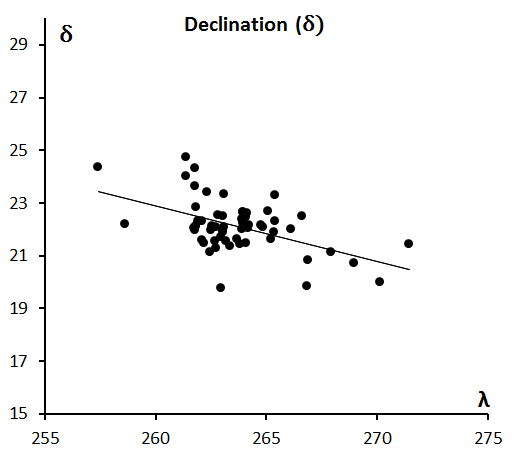
Figure 8 – Linear fit for the declination δ in function of the solar longitude λʘ.
With a geocentric velocity vg of 59.6 km/s the December alpha Bootids (DAB-497) compare very well with the Perseids in August. These meteors start well above the average meteor population in height, with an average beginning height of 109.2±4.7 km and an ending height at 93.8±6.4 km. The Perseids for instance start at 110.9±4.0 km and end at 98.0±4.8 km (Roggemans, 2017).
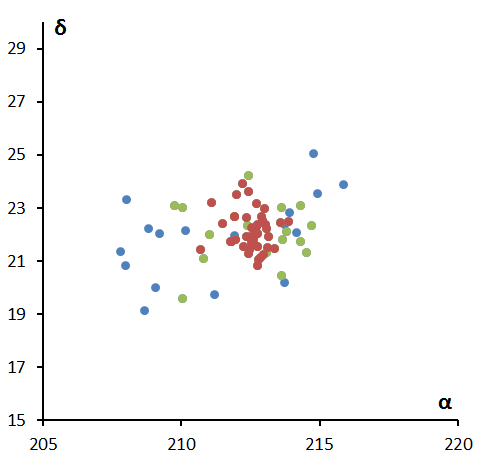
Figure 9 – Radiant drift corrected radiants for 78 orbits that fullfil DD < 0.08 (blue), 60 orbits that fit a higher threshold of DD < 0.06 (green) and 43 orbits with the highest threshold DD < 0.04 (red).
A striking characteristic is that 42 of the 78 identified DAB meteors had negative magnitudes, with a remarkable absence of faint meteors in the selection, the faintest DAB orbit was obtained for a +2.0 magnitude meteor. Without drawing any conclusions, the large portion of bright meteors and this type of orbit may be an indication that this stream is a remnant of some old cometary debris on a retrograde Halley-type orbit.
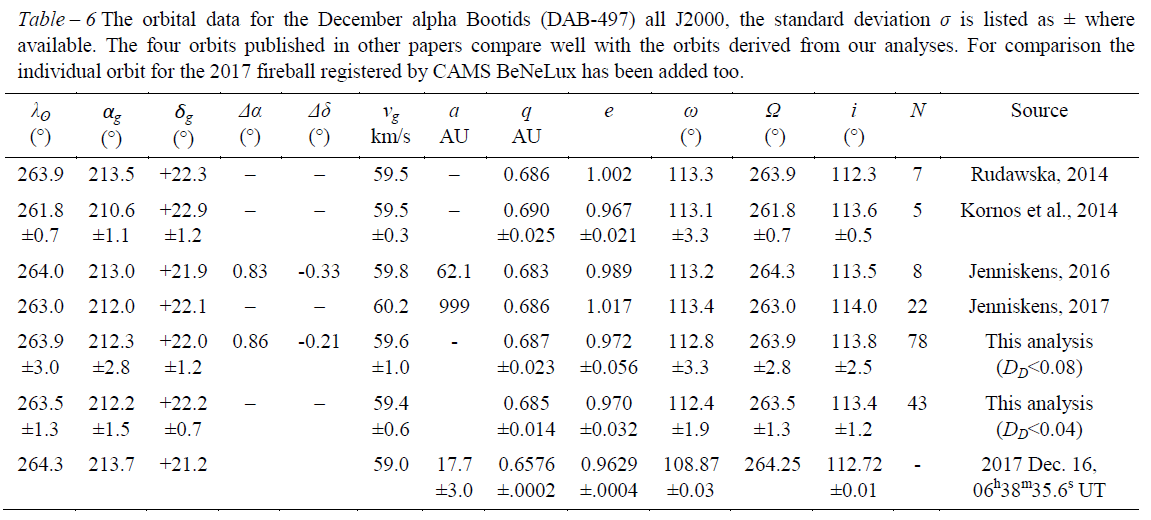
10 Conclusion
Rather few orbits have been listed for the December alpha Bootids based on data available until 2012. A search on the orbital data from the major video camera networks worldwide, listing ~635000 orbits available end 2017, resulted in 78 candidate orbits. An analysis of each dataset per network as well as for the combined data reveals the clustering of orbits that are perfectly comparable to the previously published orbits for this shower. Members of this shower have been detected in each year since 2006 in a time span between 257° and 273° in λʘ with a maximum at about λʘ = 263.9°. There is no indication for any periodicity in the stream activity. The DAB meteors ablate at heights comparable to the Perseids (similar velocity) and the shower is rich in bright meteors and deficient in faint meteors.
From this analysis it appears appropriate to consider the December alpha Bootids (DAB-497) as an established meteor stream.
Acknowledgment
The authors are very grateful to the network coordinators and their camera operators of the following networks: Croatian Meteor Network (CMN), EDMOND[1],[2], SonotaCo Network Simultaneously Observed Meteor Data Sets SNM2007-SNM2016[3] and CAMS. Many thanks to all participants in the CAMS BeNeLux network for their dedicated efforts:
Hans Betlem (Leiden, CAMS 371, 372 and 373), Felix Bettonvil (Utrecht, CAMS 376 and 377) , Jean-Marie Biets (Wilderen, CAMS 380, 381 and 382), Martin Breukers (Hengelo, CAMS 320, 321, 322, 323, 324, 325, 326 and 327), Bart Dessoy (Zoersel, CAMS 397, 398, 804, 805 and 806), Franky Dubois (Langemark, CAMS 386), Luc Gobin (Mechelen, CAMS 390, 391, 807 and 808), Robert Haas (Alphen aan de Rijn, CAMS 360, 361, 362, 363, 364, 365, 367 and 368), Robert Haas / Edwin van Dijk (Burlage, CAMS 801, 802, 821 and 822), Klaas Jobse (Oostkapelle, CAMS 330, 331, 332, 333, 334, 337, 338 and 339) , Carl Johannink (Gronau, CAMS 311, 312, 313, 314, 315, 316, 317 and 318), Hervé Lamy (Dourbes / Ukkel, CAMS 394 and 395/ 393), Koen Miskotte (Ermelo, CAMS 351, 352, 353 and 354), Piet Neels (Ooltgensplaat, CAMS 340, 341, 342, 343, 344 and 345, 349, 840), Tim Polfliet (Gent, CAMS 396), Steve Rau (Zillebeke, CAMS 385 and 387), Paul Roggemans (Mechelen, CAMS 383, 384, 388, 389, 399 and 809), Hans Schremmer (Niederkruechten, CAMS 803) and Erwin van Ballegoij (CAMS 347 and 348).
Their efforts are most important for the achievements of our network.
References
Drummond J. D. (1981). “A test of comet and meteor shower associations”. Icarus, 45, 545–553.
Galligan D.P. (2001). “Performance of the D-criteria in recovery of meteoroid stream orbits in a radar data set”. Mon. Not. R. Astron. Soc., 327, 623–628.
Jenniskens P., Gural P. S., Grigsby B., Dynneson L. , Koop M. and Holman D. (2011). “CAMS: Cameras for Allsky Meteor Surveillance to validate minor meteor showers”. Icarus, 216, 40–61.
Jenniskens P. and Nénon Q. (2016). “CAMS verification of single-linked high-threshold D-criterion detected meteor showers”. Icarus, 266, 371–383.
Jenniskens P. (2017). Submitted to Icarus.
Jopek T. J. (1993). “Remarks on the meteor orbital similarity D-criterion”. Icarus, 106, 603–607.
Kornos L., Koukal J., Piffl R., Toth J. (2013). “Database of meteoroid orbits from several European video networks”. In Gyssens M., Roggemans P., editors, Proceedings of the International Meteor Conference, Canary Islands, Spain, 20–23 September 2012, pages 21–25.
Kornoš L., Matlovič P., Rudawska R., Tóth J., Hajduková M. Jr., Koukal J. and Piffl R. (2014). “Confirmation and characterization of IAU temporary meteor showers in EDMOND database”. In Jopek T. J., Rietmeijer F. J. M., Watanabe J., Williams I. P., editors, Meteoroids 2013, Proceedings of the Meteoroids 2013 Conference, August 26-30, 2013. A.M. University, Poznań, Poland, pages 225–233.
Roggemans P. (2017). “Variation in heights of CAMS meteor trajectories”. eMN, 2, 80–86.
Rudawska R., Jenniskens P. (2014). “New meteor showers identified in the CAMS and SonotaCo meteoroid orbit surveys”. In Jopek T.J.,Rietmeijer F.J.M.,Watanabe J.,Williams I.P., editors, Meteoroids 2013, Proceedings of the Meteoroids 2013 Conference, August 26-30, 2013. A.M. University, Poznań, Poland, pages 217–224.
Šegon D., Andreic Z., Korlevic K., Novoselnik F., Vida D. (2012). “Croatian Meteor Network Catalogue of Orbits for 2007”. WGN, Journal of the International Meteor Organization, 40, 94–97.
SonotaCo (2009). “A meteor shower catalog based on video observations in 2007-2008”. WGN, Journal of the International Meteor Organization, 37,
55–62.
Southworth R. R. and Hawkins G. S. (1963). “Statistics of meteor streams”. Smithson. Contrib. Astrophys., 7, 261–286.
[1] http://www.daa.fmph.uniba.sk/edmond






